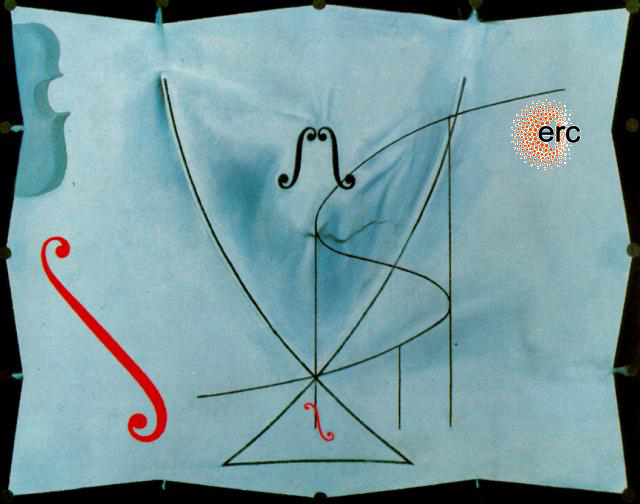- New counterexamples to Strichartz estimates for the wave equation on a 2D model convex domain, O. Ivanovici, G. Lebeau and F. Planchon
Journal de L’Ecole Polytechnique, to appear
Abstract : We prove that the range of Strichartz estimates on a model 2D convex domain may be further restricted compared to the known counterexamples. Our new family ofcounterexamples is built on the parametrix construction from our recent paper “Dispersion for the wave equation inside strictly convex domains”. Interestingly enough, it is sharp in at least some regions of phase space.
O. Ivanovici, G. Lebeau and F. Planchon, submitted
Abstract : We prove sharper Strichartz estimates than expected from the optimal dispersion bounds. This follows from taking full advantage of the space-time localization of caustics. Several improvements on the parametrix construction from our previous works are obtained along theway and are of independent interest.
F. Planchon, N. Tzvetkov and N. Visciglia,
Mathematische Annalen volume 378, pages 389–423(2020)
Abstract : The authors prove a newsmoothing type property for solutions of the 1d quintic Schrödinger equation.As a consequence, they prove that a family of natural gaussian measures are quasi-invariant under the flow ofthis equation. In the defocusing case,they prove globalin time quasi-invariance while in the focusing case they only get local in time quasi-invariance because of a blow-up obstruction. Their results extend as well to generic oddpower nonlinearities.
- Long time existence for fully nonlinear NLS with small Cauchy data on the circle, F. Roberto and F. Iandoli,
An. Sc Norm. Super Pisa Cl. Sci.(5), vol. XXII (2021), 109-182
Abstract : The authors prove long time existence for a large class of fully nonlinear, reversible and parity preserving Schrödinger equations on the one dimensional torus. They show that for any initial condition even in x, regular enough and of size ε sufficiently small, the life span of the solution is of order ε−N for any N∈ℕ if some non resonance conditions are fulfilled. After a paralinearization of the equation we perform several para-differential changes of variables which diagonalize the system up to a very regularizing term. Once achieved the diagonalization, they construct modified energies for the solution by means of Birkhoff normal forms techniques.
- A non-linear Egorov theorem and Poincaré-Birkhoff normal forms for quasi-linear pdes on the circle, F. Roberto and F. Iandoli, submitted
Long-time existence for semi-linear beam equations on irrational tori, Joackim Bernier, Roberto Feola, Benoît Grébert, Felice Iandoli,
Abstract : The study of dispersive properties of Schrödinger operators with point interactions is a fundamental tool for understanding the behavior of many body quantum systems interacting with very short range potential, whose dynamics can be approximated by non linear Schrödinger equations with singular interactions. In this work we proved that, in the case of one point interaction in ℝ3, the perturbed Laplacian satisfies the same L p − L q estimates of the free Laplacian in the smaller regime q ∈ [2, 3). These estimates are implied by a recent result concerning the L p boundedness of the wave operators for the perturbed Laplacian. Our approach, however, is more direct and relatively simple, and could potentially be useful to prove optimal weighted estimates also in the regime q ≥ 3.
- Dispersive estimates for the semi-classical Schrödinger equation inside a strictly convex domain, Oana Ivanovici
Abstract : We prove dispersive estimate with 1/4 loss for the semi-classical Schrödinger flow inside a Friedlander model domain in any dimension d>1. This result is optimal.
- Dispersive estimates inside the Friedlander model domain for the Klein-Gordon equation and the wave equation in large time, Oana Ivanovici
Discrete and Continuous Dynamical Systems, to appear
Abstract : We prove global in time dispersion estimates for the wave and the Klein-Gordon equation inside the Friedlander domain by taking full advantage of the space-time localization of caustics and a precise estimate of the number of waves that may cross at a given, large time. Moreover, we uncover a significant difference between Klein-Gordon and the wave equation in the low frequency, large time regime, where Klein-Gordon exhibits a worse decay that the wave, unlike in the flat space.
Oana Ivanovici, Richard Lascar, Gilles Lebeau and Fabrice Planchon, submitted
Abstract : In this paper, we consider the wave equation on a strictly convex domain Ω of dimension d ≥ 2 with smooth boundary and with Dirichlet boundary conditions. We construct a sharp local in time parametrix and then proceed to obtain dispersion estimates: our fixed time decay rate for the Green function exhibits a 1/4 loss with respect to the boundary less case. We precisely describe where and when these losses occur and relate them to swallowtail type singularities in the wave front set, proving that our decay is optimal. Moreover, we derive better than expected Strichartz estimates, balancing lossy long time estimates at a given incidence with short time ones with no loss: for d = 3, it heuristically means that, on average the decay loss is only 1/6.
The new methods in this paper (compared to the Friedlander model case) provide a much deeper understanding of the complex propagation pattern near the boundary and extends the parametrix construction to the largest possible phase space region. This may have far reaching consequences, beyond pointwise bounds, as the parametrix will prove to bea powerful tool to prove sharp propagation of singularities results which were out of reach until now.
- Dispersion estimates for the wave and the Schrödinger equations outside a ball and counterexamples, Oana Ivanovici and Gilles Lebeau
Abstract : We consider the wave and the Schrödinger equations with Dirichlet boundary conditions in the exterior of a ball in R^d. In dimension d=3 we construct a sharp, global in time parametrix and then proceed to obtain sharp dispersive estimates, matching the R^3 case, for all frequencies (low and high). If d ≥4 we provide an explicit solution to the wave equation localized at large frequency 1/h with data a Dirac mass at a point Q_0at large distance s from the center of the ball : taking s~h^{-1/3}, the decay rate of that solution exhibits a (t/h)^{(d-3)/4} loss with respect to the boundary less case, that occurs at t~ 2s with an observation point being symmetric to Q_0 with respect to the center of the ball (at the Poisson Arago spot). A similar counterexample is also obtained for the Schrödinger flow.
The question about whether or not dispersion did hold outside general strictly convex obstacles was raised more than 20 years ago : in this work we give sharp answers which highlight the importance of diffractive effects, especially in higher dimensions where we provide unexpected counterexamples.


